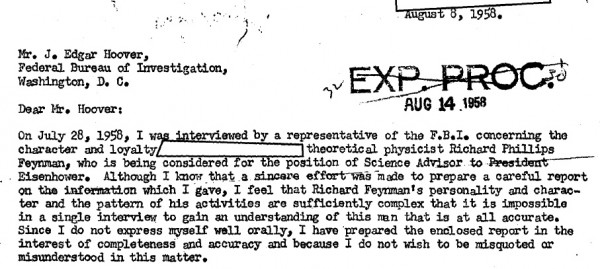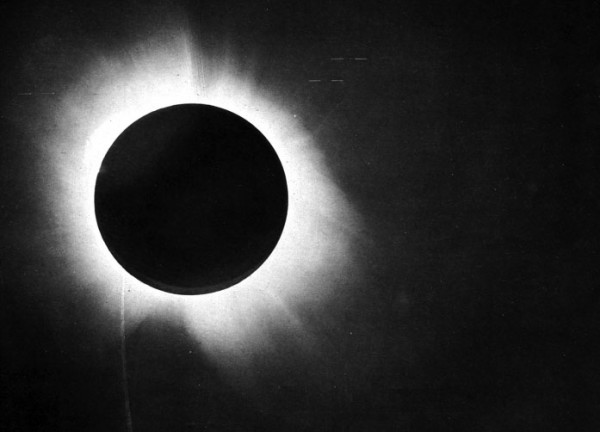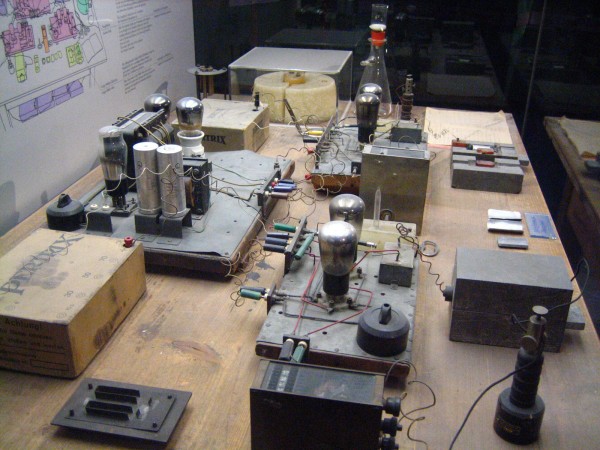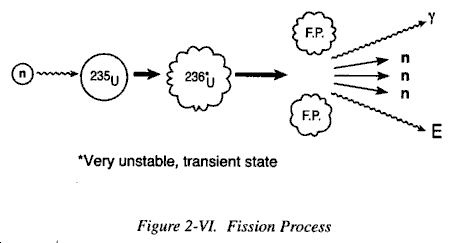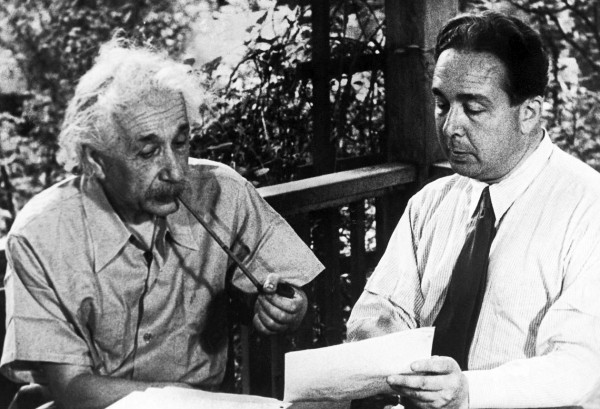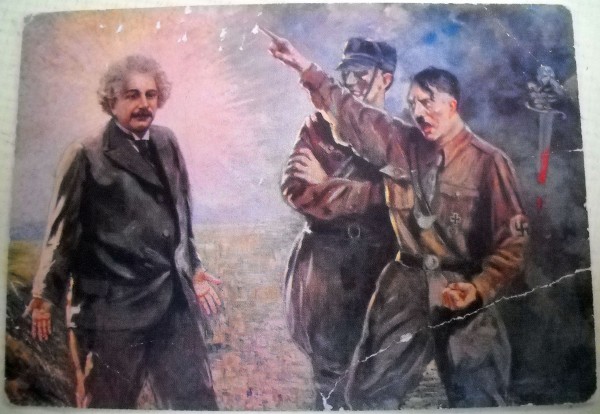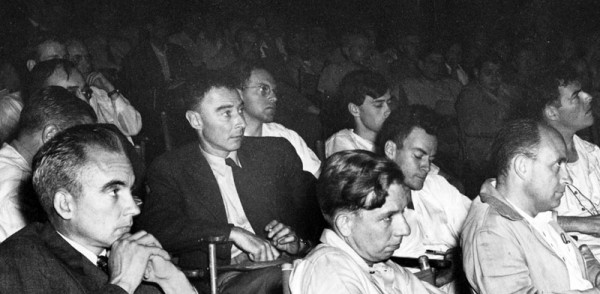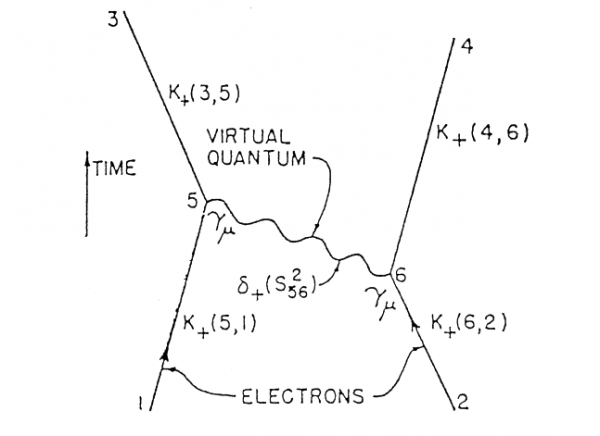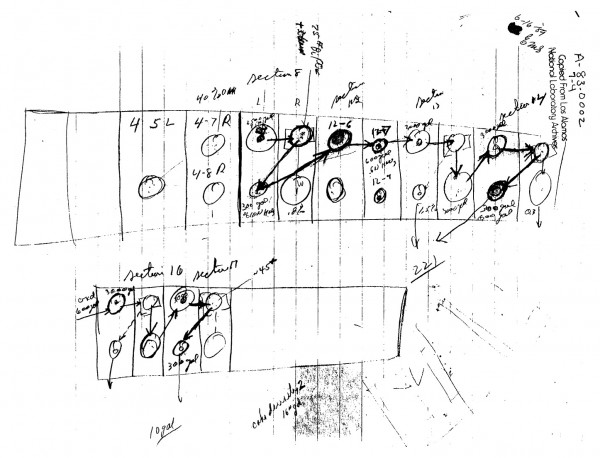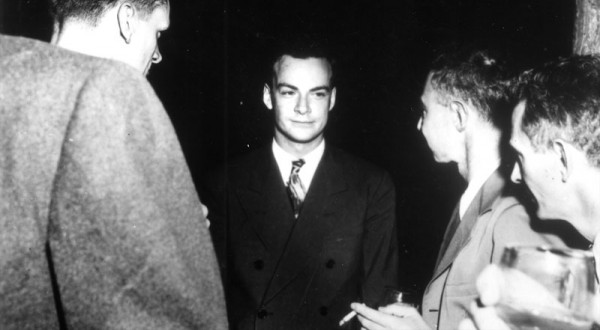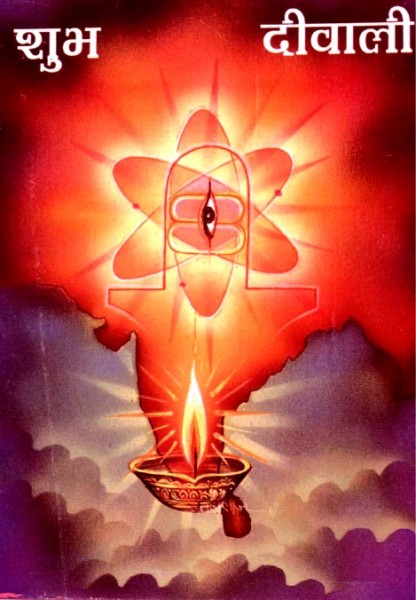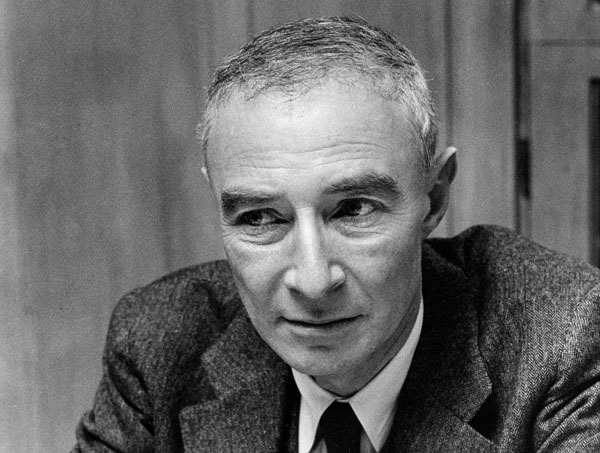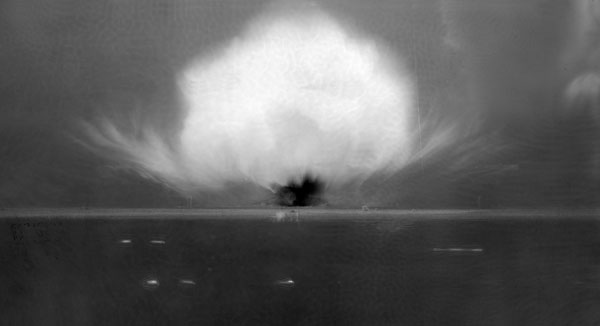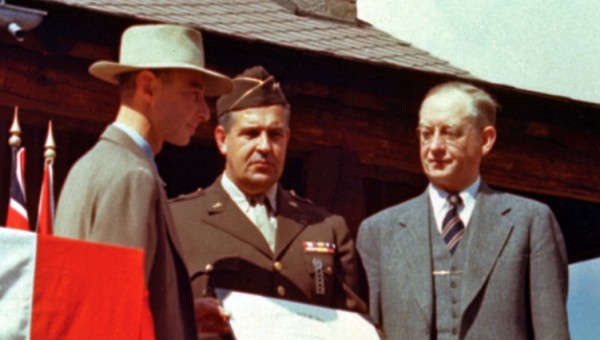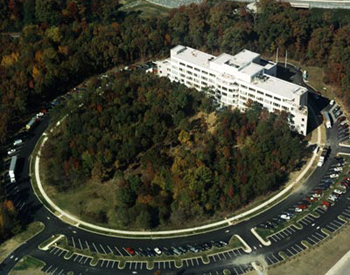One of the many physicists who came under official FBI scrutiny during the Cold War was Richard Feynman. Feynman’s work on the bomb at Los Alamos, combined with his fame, penchant for telling stories about safe-cracking, and occasional consideration for being on government committees led him to be investigated a few times, to see where is loyalties lay. In March 2012, the website MuckRock filed a Freedom of Information Act (FOIA) request to obtain and release Feynman’s full FBI file (minus deletions). It got a lot of Internet buzz when it first came out, but from the look of most of it, the articles about it didn’t read it very carefully — they just mined it for a few good quotes.

Would you give this man a security clearance? From the Emilio Segrè Visual Archives.
And good quotes it has. Like most FBI files for people who had security clearances at one point or another, it is mostly concerned with interviews with friends and colleagues about Feynman’s “character and loyalty.” Most of the file was filled out in 1958, when Feynman was apparently being considered for a position on Eisenhower’s President’s Science Advisory Committee (PSAC), a very high-level advisory board created in the wake of Sputnik. Most of the testimonies look like this:
“…a brilliant physicist… discreet, loyal American citizen of good character and associates and recommended him for a position of trust…” And so on.
And sometimes you can figure out the basics of what the blank spots say from the context. The first blank spot is someone who Feynman worked with during a summer of 1956 visit to Brookhaven National Laboratory, and we can deduce from the text that: 1. the person is a man, and 2. the person is not someone Feynman knew well before that period. We could if we were really tempted to, try to figure out (from archival files or databases), the names of several candidates based on these properties, and then see if they fit into the blank spot (since it is a fixed-width font). The second blank spot is the name of the interviewing FBI agent (SA = Special Agent). In this case, it is such a boring endorsement that it doesn’t seem worth the effort. (The b7C and b7D on the right are FOIA exemption references that indicate that the blanked out parts have been done so to protect the “privacy” and hide the name of the confidential informant.)
But there is a much more interesting letter in the file, and it is one that several blogs and news sites picked up on at the time. It is dated August 8, 1958, and is an epic 9-page attack on Feynman’s character, written directly to J. Edgar Hoover. It argues that “Feynman is a master of deception, and that his greatest talent lies in intrigue, not physics”:
I do not know—but I believe that Richard Feynman is either a Communist or very strongly pro-Communist—and as such as a very definite security risk. This man is, in my opinion, an extremely complex and dangerous person, a very dangerous person to have in a position of public trust… In matters of intrigue Richard Feynman is, I believe immensely clever—indeed a genius—and he is, I further believe, completely ruthless, unhampered by morals, ethics, or religion—and will stop at absolutely nothing to achieve his ends.
You can read the least-redacted version of the letter here. A lot of the sites which posted it did so in sort of a confused way — talking about how it reflected that the FBI was dubious about Feynman (the FBI do not issue opinions of this sort, and the letter is just part of his file), and wondering which of his colleagues would be mean enough to write such a thing.
I’ve read a lot of FBI files of physicists, and plenty of them are full of anonymous, smearing letters to Hoover. This one sticks out as unusual, though, both in its vehemence and its personal specificity. The author of the letter is not some anti-Communist nut who writes nasty letters as a hobby. It hits much closer to home than most smears.
So who smeared Feynman? What can we infer about the letter’s author, reading between the lines?
- The author is someone who knew Feynman pretty well. This is a letter written by someone who has heard a lot of Richard Feynman stories — they are well-acquainted with his lock-picking Los Alamos stories, for example. (And this was several decades before those stories appeared in books.) They know that he’s very handy with mechanical devices, they know his friends, they claim to know how Feynman has talked about his political positions over the years and how he is registered to vote (Republican).
- The author is religious and conservative. Among the author’s criticisms of Feynman is that he is irreligious and a fake Republican. The author repeatedly invokes Eisenhower’s name in awe and respect, and offers to swear either on a Bible or to the President himself. The author talks of Feynman’s “long hatred of Republicans,” but knows that Feynman registered as a Republican in 1956 — which the author believes to have been part of a long-game deception to infiltrate the government. The author could be faking it, of course, but it doesn’t read like that to me.
- The author knows a lot about his scientific contacts and knows he is considered brilliant by his peers, but is probably not a physicist. On page 6 of the letter, the author names lots of Feynman’s scientific associations and acknowledges that they would all give Feynman high marks. But the author also makes some rather elementary errors: some of the names are obviously misspelled — “Enerico Fermi” and “Claus Fuchs.” It is hard for me to believe that any of his Los Alamos peers would misspell those names in 1956, much less that of Fermi’s. Of course, we all make typos. But the tenor of the letter suggests someone who was pretty closely connected with Feynman’s scientific world, but was not a member of it.
- The person is someone who the FBI had already identified as worth interviewing, prior to the letter. This is obvious from the first sentence (“On July 28, 1958, I was interviewed by a representative of the FBI…”) but was missed by a lot of the sites that wrote on the file. This tells us a few things. For one, it tells us that this person was already someone whose connection to Feynman was superficially obvious — again, not an anonymous ranter, but someone relatively close. For another, it lets us trace through the file and figure out where the interview happened. And indeed, we find that on 7/28/58, an FBI agent from the Butte office interviewed someone in Boise, Idaho, who talked about Feynman’s lock-picking stories, and had a rare negative conclusion about his suitability. Probably the same person.
- The person who wrote the letter is a woman. Wait, what? Indeed! Despite a lot of redaction to keep the identity of the letter writer and interviewee a secret, there are a few tiny slips: a reference to “her” and “she” in a few of the FBI memos. This is the sort of subtle thing that must make file redactors kick themselves, because it’s the sort of little slip-up that gives away a lot of information.
So who smeared Feynman? I submit a theory: I suspect it was his second wife, Mary Louise Bell, to whom he was married from 1952 until 1956. That’s not a long marriage, but it’s plenty of time to hear someone’s stories ad nauseam, and plenty of time to learn to hate someone. From James Gleick’s Feynman biography, Genius:
His friends refused to understand why he finally chose to settle down with Mary Louise Bell of Neodesha, Kansas, who had met him in a Cornell cafeteria and pursued him—they said cattily—all the way to Pasadena and finally accepted his proposal by mail from Rio de Janeiro. … They married as soon as he returned from Brazil, in June 1952, and they honeymooned in Mexico and Guatemala, where they ran up and down Mayan pyramids. He made her laugh, but he also frightened her with what she decided was a violent temper. … She nagged him, they thought. She liked to tell people that he was not “evolved” to the point of appreciating music and that sometimes she thought she was married to an uneducated man with a Ph.D. … Politically she was an extreme conservative, unlike most of Feynman’s colleagues, and as the Oppenheimer security hearings began, she irritated Feynman by saying, “Where there’s smoke there’s fire.” He, too, voted Republican, at least for a while. Divorce was inevitable—Feynman realized early that they should not have children, he confided in his sister—but it was nearly four years before they finally separated.
Further evidence from the file: Feynman’s only connection to Boise, Idaho, is through Bell (they were married there in late June 1952). The final divorce settlement was rendered only in May 1958 — two months before the FBI interviewed the letter writer. It was an extremely ugly, long (2 years!) divorce hearing: it made the newspapers because of Bell’s allegations of “extreme cruelty” by Feynman, including the notion that he spent all of his waking hours either doing calculus and playing the bongos.
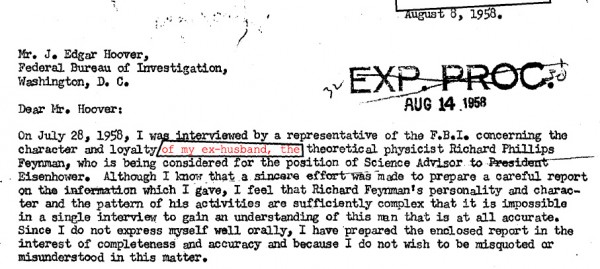
Another approach to these files is to try and guess missing words based on the fixed-width font size. One possible fit shown here, for example. I am always a little un-sure about this approach, though, since lots of other things could fit, as well.
Of course, there’s always another possibility, such as the idea that it might not be Bell herself, but her mother, sister, close friend, etc. But there’s a level of personal animosity in the letter that is quite deep. There’s a sense that this letter writer is the only person in the entire FBI file who is fed up with Feynman’s self-serving stories and not engaged in any form of hero-worship just because he is a well-respected genius. It really does read like someone who just went through a very messy divorce with the guy.
As an aside, I talked about this with my own wife, and she noted how gendered a lot of the Feynman stuff is. His “smartest man in the room” stories are an awfully common male trope, and the emotional self-denial that comes through in his stories (e.g. about his first wife, Arline) reflects a guy who is trying very hard to put on a public face that is strongly within typical American masculinity. Many of the traits discussed in the smear letter are ones Feynman himself would own up to gladly, but were turned on their head — Feynman’s anti-secrecy exploits at Los Alamos are not seen as evidence of the inefficiency of secrecy, but as evidence of Feynman’s own juvenility. Somehow I don’t see Feynman’s male colleagues making that sort of twist. This isn’t to be essentialist, or to claim that men couldn’t smear — but the male smears usually had more emphasis on the Communism and less emphasis on his emotional stability.
Feynman never became a member of PSAC. Was it because of this letter, the one piece of strongly negative testimony in his file? We would need more records (and not the FBI’s) to know that: the FBI did not make recommendations as to whether someone should be hired, it simply produced a summary of the information it received (often with an emphasis on the derogatory information, though), and let the agency in question decide what it wanted to do about it. Feynman’s lack of PSAC participation may have had to do with other factors; it is not clear that he would have even wanted to be on the committee, given his avowed distaste for government work in the Cold War period. But it’s a strong letter, so it might have had an effect — it’s a letter from someone who knew Feynman, and his flaws, very well.


